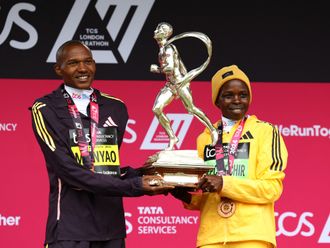At the Atlanta Olympics in 1996, as many as 26 countries refrained from sending female athletes to compete on the world’s biggest sporting stage. However, by Beijing 2008 that list had shrunk to just three: Saudi Arabia, Qatar and Brunei.
Four years down the line, London 2012 is set to be the first Olympics in history whereby every participating nation will have at least one female representative. And with the inclusion of women’s boxing, it will also be the first Olympics to involve female athletes in every sport.
Saudi Arabia, who opened the doors for women participants last month, were the last one to complete the numbers when they named two female athletes on July 9.
Here, Gulf News takes a look at the women participants from the Arab world at the Games.
The first female Olympic champion was a Spartan princess called Kynisca, in 392 BC. She was also the first woman to become a champion horse trainer when her horses and chariot competed and won in the Ancient Olympic Games.
Women had their own athletic games of Hera from about 1000 BC.
Pomegranates, symbols of fertilty, were prizes at the women’s games.
Women were originally the prizes in Ancient Olympic chariot races.
In the first modern Olympics of 1896, women were not allowed to compete, but there was an unofficial competitor in the marathon, a poor Greek woman who became known as ‘Melpomene’.
Melpomene’s real name was Stamati Revithi. She was not allowed to compete in the men’s race, but ran by herself the next day. The final lap was completed outside the stadium as she was refused entry to the stadium.
1900 was the year the World Exhibition was scheduled to take place in Paris, with celebrations and events akin to our own millennium celebrations.
The Olympic Games ran from 14 May to 28 October and were considered by many to be part of the World Exhibition. Some of the competitors did not know if they were in the Olympic Games or the World Fair.
The organisers of the World Exhibition seemed unconcerned about the rights and wrongs of women competing, so their presence was not an issue. There is still confusion as to which events were Olympic and which were World Fair events.
Our view is that the first women competitors in the Olympic Games of 1900 in chronological order were: Helen de Pourtales, Switzerland (yachting), Elvira Guerra, France (equestrian), Mme Ohnier and Madame Depres, France (croquet), Charlotte Cooper, Great Britain (tennis), Margaret Abbott, USA (golf), Madame Maison, France (ballooning).
The first gold medallists were Helen de Pourtales (mixed event) and Charlotte Cooper (individual women’s event).
Women’s boxing was included in the 1904 Olympic Games in St Louis, USA, as a demonstration or exhibition sport. Archery also made its first appearance as an Olympic sport for women.
In 1906, in the interim Games in Greece, Danish women took part in a gymnastics demonstration but women had to wait until 1928 before gymnastics became an official Olympic event.
Tennis was the only sport in the interim Games for women but only Greek and French women took part.
Two swimming events and highboard diving were included in the 1912 Games.
Women’s fencing arrived in 1924.
Athletics provided the biggest hurdle of all. Eventually in 1928 in Amsterdam, the first women competed in five athletic events. The first track and field gold medallist was 16-year-old Betty Robinson (USA) who won the 100 metres.
There were no female members of the International Olympic Committee until 1981.











